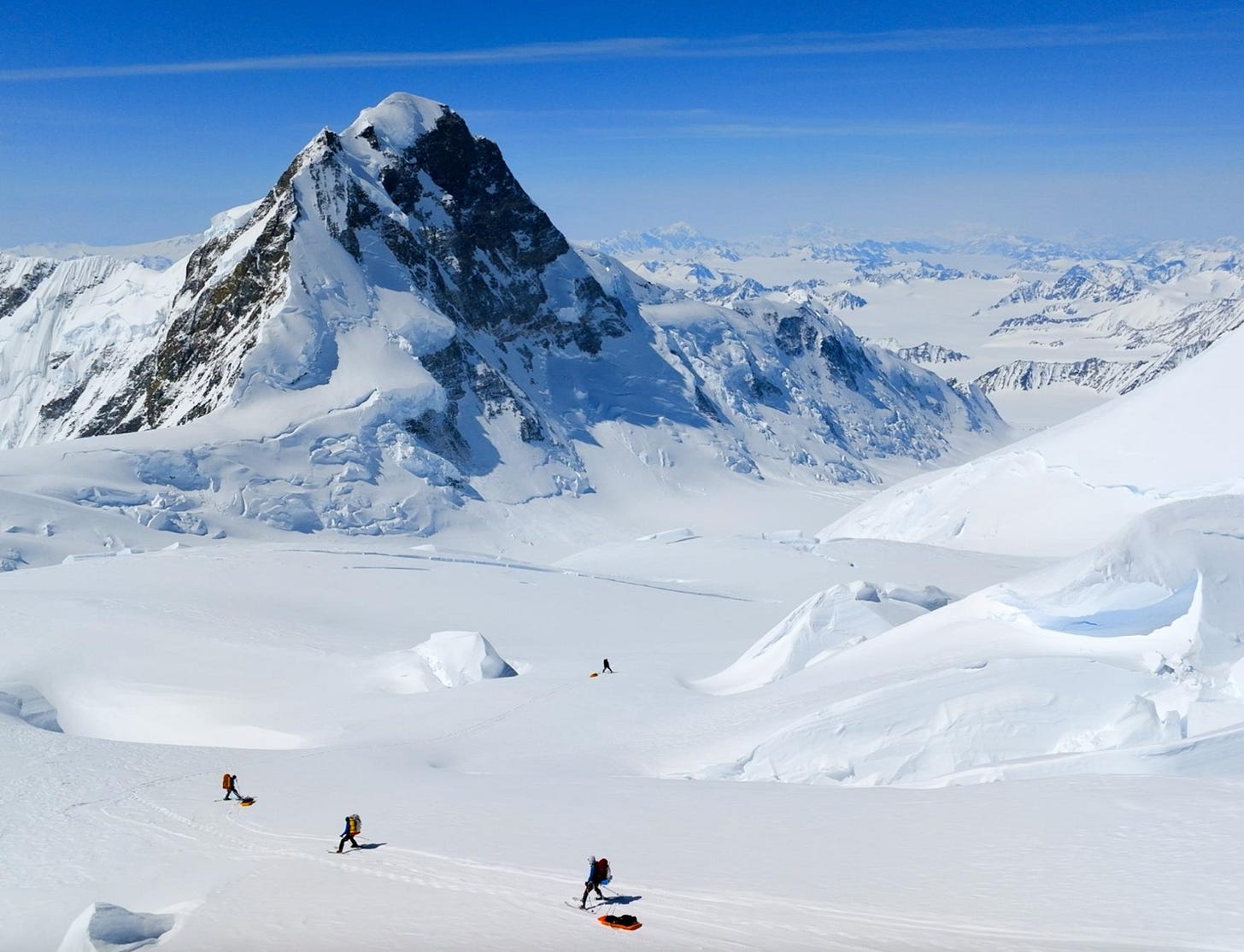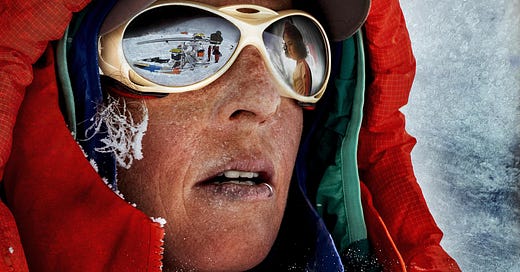For Winter: An Inspiring Story of Science & Sacrifice
In our first post of the year, we review the National Geographic documentary, For Winter, which tells the story of Dr. Alison Criscitiello's quest to collect ice cores from Canada's highest mountain.
When you picture a scientist, your mind probably conjures up images of individuals clad in lab coats, pipetting liquids into tubes and running experiments. A woman leading a team of climate scientists and instrument specialists up Canada’s highest mountain in pursuit of ice cores is likely not the first image that comes to mind, but it will certainly give those other preconceived notions a run for their money after watching the recent documentary, For Winter. Produced by the National Geographic Society’s Impact Story Lab, which works alongside National Geographic Explorers to help tell the story of their work, For Winter focuses on ice core scientist and National Geographic Explorer Dr. Alison Criscitiello’s expedition to collect ice cores from Mount Logan, Canada’s tallest mountain. Standing at 20,000 feet tall, with temperatures that can dip to negative 40 degrees Celsius, Criscitiello’s expedition is no small feat–in fact, it took around five years alone just to plan it.
But, before we get into the details of the expedition, let’s backtrack: what are ice cores, and why would a scientist be compelled to weather such terrible conditions to collect them? You may be more used to thinking about cores in the context of soil or layers of the earth, but the same principle applies to an ice core. Quite simply, it is a cylindrical core usually removed from a glacier or ice sheet, which can be used to understand historical trends in planetary climate. The amount of information that can be extracted is extensive–in Criscitiello’s own words, “What don’t we learn from ice cores?” From greenhouse gas concentrations to the presence of pollutants, ice cores can reveal how the local atmosphere and climate have changed over time as well as how they have been impacted by human activity.

These particular cores, however, are special for two reasons: the first being that they come from a nonpolar region (regions which have historically been less surveyed compared to polar regions), and the second being the nature of their location. Ice cores from high altitude locations like Mount Logan are underrepresented due to the difficulty inherent in traveling to those places and collecting cores, but this is something Criscitiello is determined to change–especially since these cores may provide key insights that could fuel future climate solutions. For Criscitiello, these cores are “the last remaining puzzle pieces in the climate picture,” a necessary data point for understanding the planet’s history as a whole. In pursuing this quest, Criscitiello aims not only to analyze the cores alongside her lab, but to contribute to an archive in which future researchers can also draw upon these cores for their own work.
But, what draws the scientist behind this mission, Dr. Alison Criscitiello, to collect and study ice cores? Originally from Boston, Criscitiello grew up exploring the Northeast’s mountains alongside her twin sister. These outdoor adventures quickly grew into an interest in mountain climbing and exploring, leading Cristiciello to become a U.S. Climbing Ranger. However, as Criscitiello’s sister tells it, while the budding scientist loved the physical aspect of her work, she was lacking the intellectual stimulation to accompany it. This led Criscitiello to pursue a scientific career, earning the first Ph.D. in Glaciology ever conferred by MIT in 2014. Currently, she is the director of the University of Alberta’s Ice Core Laboratory, where she studies a variety of topics related to climate science, such as human impacts on remote landscapes and climate variability in nonpolar regions. Additionally, she is a National Geographic Explorer and contributes to Perpetual Planet Expeditions (a partnership between National Geographic and Rolex to understand how rare, sensitive areas of the planet are being affected by climate change), which supported her Mount Logan summit.
After Dr. Criscitiello and her team settled on Mount Logan, they next had to determine the best way of climbing the mountain while safely transporting themselves and their equipment to the summit, where they would drill and collect the ice cores. To give you a sense of the scale of this effort, the drill alone took three helicopter trips to transport to the scientists’ base camp. Together with her team of climate scientists, climbing experts, and a drill specialist, Criscitiello would have to climb for ten days with equipment in tow to make it to their designated drill site. You may be wondering–why not just helicopter directly to the site? Why undergo such a laborious and dangerous climb? Unfortunately, because the summit of Mount Logan rests at around 20,000 feet in elevation, your body needs time to gradually acclimate to the altitude. If you were to land directly at the top, you would quickly succumb to the altitude and develop any number of severe health issues within a few hours. This is a risk even to those ascending the mountain on foot. To make sure they were acclimating properly, the team had to technically ascend each section twice–they would go halfway up the climb with their equipment, ski down to base camp, and climb again the next day while bringing their equipment the other half of the way to the next base.

The peril of this trip cannot be understated–the first time Criscitiello ever ascended Mount Logan recreationally, she developed second degree frostbite. Add an entire team and sensitive scientific equipment, and the picture quickly becomes more complicated. In fact, during planning, Criscitiello and her team accounted for this by assuming that half of the team wouldn’t make it and would need to be medically evacuated. As leader of the expedition, Criscitiello has the dual responsibility of not only supervising the science, but also caring for the health and safety of her team–an additional burden that rests solely on her shoulders throughout the climb. As the documentary follows Criscitiello and her team up to the summit (filming only thirty minutes a day due to the conditions on the mountain), viewers gain a newfound appreciation for the physical and emotional toil that scientists must weather to get the data they are after.
While For Winter chronicles the ins and outs of this intricate and challenging expedition, it also delves into Criscitiello’s personal life and her motivations for pursuing this kind of research. Throughout the documentary, we meet Criscitiello’s wife, Amy, as well as their endearing daughter, Winter, for whom the documentary is named after. Through them, we gain insight into Criscitiello’s motivations in pursuing this work; namely, to provide her daughter’s generation with a fighting chance to understand and combat climate change and to provide girls like Winter with the representation and support needed to pursue scientific careers. As Amy puts it, they want Winter (and her soon-to-be-born sibling, Juniper) to see “strong, brave, badass women leading expeditions” and to know that they can do it too. However noble and awe-inspiring these sentiments are, though, For Winter also shows the difficulties inherent in the isolation that comes with these expeditions, which is particularly illustrated by a poignant moment in which a teary-eyed Criscitiello opens letters from her family while hunkering down in her tent. This work requires sacrifice–not just from the scientists taking part in the expedition, but from the loved ones that support them too.
Only an hour long, the documentary is a thrilling but emotional journey that takes viewers through not only the difficulties of conducting this kind of research, but the personal sacrifice involved as well. Despite these challenges, Dr. Criscitiello has no plans of stopping, with an expedition to the Muller Icecap underway this year. As climate change continues to ravage the planet–take the recent wildfires in Los Angeles as the latest example–For Winter shows just how necessary this work is and the possibilities that we can create when we look towards the future.
For Winter can be viewed at upcoming screenings in select cities. To learn more about the documentary and future screenings, click here.




